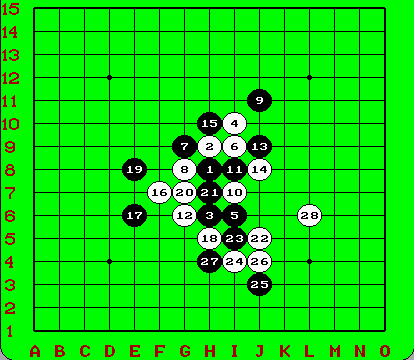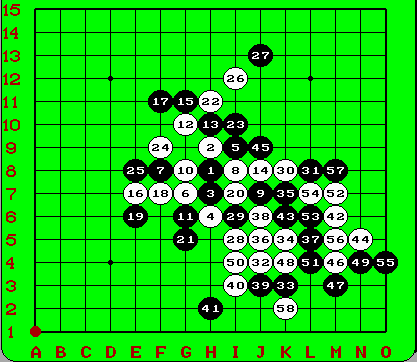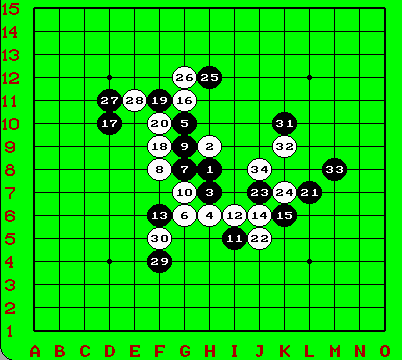

1st game 8th of October in Kyoto 2nd game 22th of October in Kyoto 3rd game 5th of November in Kobe
Link to the results of the 32 first Mejin-sen Finals.
The match between Meijin and World Champion Norihiko Kawamura and challenger Kazuto Hasegawa was awaited with a very big interest. It is the first Meijinmatch in last 20 years without fantastical Shigeru Nakamura, who lost last year against Kawamura 2:3. Is really Kawamura so strong as we saw in last Meijinmatch and WC? Will Hasegawa give a real fight for a Meijin title he couldn't got from Nakamura's hands? So the big question is: Kawamura or Hasegawa?
There are also many another questions. It's the first Meijinsen-match with new opening rule. How will it work? Last years in Meijin-matches many new opening theory ideas were showed by Nakamura. Will it be the same in this match? Or will it be just an ordinary match without any great ideas and wonderful games...
In the last years these 2 players have played many games against each other, because they both are from Kyoto area and they every year play a Kyoto Champion title (Ohi-Sen) match and in many smaller local tournaments. Last year just after Kawamura's unbelievable victory in Meijinmatch Hasegawa beated new Meijin Kawamura in Ohi-Sen match 2:1. And it's sure that Kawamura wants to show this year that it was just an accident and that today he is No.1 in the world and Japan. Really his level in last year has become very high and he definitely is a main favourite, but Hasegawa always has been very dangerous opponent for him and he understands that to win against Kawamura must me easier than to beat Nakamura.The games shown are screen-shots from the program Database 4.2. This program mainly is an encyclopedia of renju games. However, you can also write your own games in this program.

As Hasegawa was tentative black, he chose Direct 11 (D11) which was his favorite opening pattern. Kawamura played as white. Black changed 13th move from ordinary move but 15th move was bad. White took advantage from 16th move and won shortly. The game ended at 28th move. 5A=10.
Even with old opening rules D11 was Hasegawa's favourite pattern in direct openings. He had won many black games in D11. In this years Meijin-tournament (MT), where for the first time the new opening rule was introduced, he played only D11 as tentative black. And also in many games among Kawamura and Hasegawa D11 were succesfully played by Hasegawa as tentative black. So it was not a surprise for Meijin, that Challenger choosed D11 again.
First 12 moves is usual tactics in D11. However I waited 5->f8 or 11-> i11. These two ways Hasegawa use to play succesfully very often recently. However in this years MT tournament we saw also the same moves (1-12) played this time. In MT's game against Nara Hasegawa played a new strange move 13->i11. Will he try it again or will he play in standart way 13-> i8 ? Or maybe we will see difficult 13-> h10, because with 13-> i11 he lost, but after standard 13-> i8 black had problems to get an advantage last years?
No, Hasegawa played an almost forgotten old move 13->13. This move became popular in Europe after 1988, when Hayakawa used it against Glukhovsky in "Stockholm Summer Trophy" and was played in Japan in 70-ies and early 80-ies. There are many possible 14 moves: j8, h10, k10, k7. Obviously k10 is weak, h10 and k7 leads to difficulties. Move 14->j8 choosen by Kawamura is good and maybe the strongest one. And now usual answer is 15-> h7, when follows 16->h5, 17->f7 and 18->h10 with difficult situation, which differs from standard D11 position (after 13->i8) with 2 stones h7 and h5. And in some situations it's very important to remember. Hasegawa new this 15th move, because he lost as white after 15-> h7 against P. Malyshev from Ukraine in WC by mail game in 1991.
Instead of that 15 Hasegawa played 15->15?? which gives an easy victory to white, which Kawamura showed very quickly...After such 15?? on the board is situation well known from 13-> h10 with extra white stone on j8, which solves all questions. Was it Hasegawa's preparing blunder? It's unbelievable, but there is an absolutely similar game with this K-H game played in Japan appr. 10 years ago! It shows that Hasegawa's preparation to this game was not good.
So, first game was very short and we even couldn't see the real strength of opponents. We just saw that Hasegawa wasn't ready to this standard 14th move. In Nakamura's times such short games were impossible, however also Nakamura lost his title in last year's match after a crazy blunder in 15th move in Game 5. Yes, sometimes it's difficult to understand japanese players...And we'll await second game with a very big impatience, because this game didn't give answers on many questions.
Kawamura was tentative black. The opening pattern was Direct 8 (D8).
It was not a surprise that Meijin Kawamura offered D8, because it's one of his favourite openings. And also it's sure that D8 will be in future (when new opening rules will be introduced worldwide) one of most popular beginnings together with D11 and D3. And everobody was waiting what will show Hasegawa, because he wasn't very good in first game, but now he had tentative white, the possibility to take the black colour and to attack hard.
Moves (1-8) are the main path in D8 and don't need any comments. Move 9th isn't the most popular, but was quite popular in the middle 80-ies, especially in Japan and also in former USSR. However my opinion is that traditional 9->f10 is better. After 9->f10 black can attack all around the board and only thing what about white can think is how to keep position. In the same time I must admit, that a clear and very good way for black after 9->f10 still hasn't found and maybe this is a reason why Hasegawa tried to play another 9th move. Plus a moment of unexpectedness, of course. After such 9->9 black, as a rule, try to surround opponent's stones in a slow, but very tight manner. Sometimes move 10->i6 was played, when white try to break immediately this embrace, but most popular is 10->10, when white agree to play in defence.
Three moves 11 are possible: 11->f7, g9 and g6 (played by Hasegawa). 11-> seems to be bad, because white can attack very sharply and get maybe even a winning situation. Move 11->g9 was very popular among ex-soviet players and my opinion is that it's the best move. But in Japanese tournaments most popular was 11->g6. I don't like this 11th, because then black gives an initiative to white without any contribution and leaves to attack them a very long time.
Moves (12-15) are standart style. 16->i11 is possible and sometimes used with success, but 16->e7 is also a very good, probably the best, move. Also 16->f7, 18->e7 doesn't change anything. After 17->17 played by Hasegawa, is possible to play immediately 18->h11, in a way which desired Nakamura approx. 10 years ago, but raining Meijin choosed little bit another tactics with a very similar idea: (18-22), which prepares a field for white future attack in the right part of the board.
I think that move 23 isn't good, because it is too much "inside" and after that white can attack without any black's counter-threats. Probably 23->j11 would be the better answer, but also after that position of black was dangerous.
With moves (24-28) white starts a genereal attack like operation "desert's storm". And Hasegawa plays bad 29, as it seems to me. I think black had to try 29->31, but they again choosed a very passive way. And during all the game I've got an impression that Hasegawa thought only about defence, in spite of fact that he had black color! And now after 30 black is in a deep trouble. It's very difficult to make any good advice after move 30 and especially after very logical and strong moves (32,34). With moves ( 36,38) white builds a very strong "heap" and move 42!!! proves that Kawamura feels himself very confident. It's a very nice move after which white has a winning situation. Hasegawa tries to protect against "long row" between points L10 and 37 with "unexpected" moves 43 and 45, but Kawamura shows a strict victory even after these moves.
To make any conclusion I must to say that Game 2 showed just like Game1, that Mr. Hasegawa wasn't really ready to this match and \ especially to play direct patterns. But maybe in Game 3 we'll see the real strength of Challenger?

Kawamura was tentative black. The opening pattern was Direct 8 (D8). 5A=7. In this last game, black, Hasegawa, used aggressive tactics. And he had advantage in this game, but he made an easy mistake when he made the 33rd move!
Comments from Meijin Kawamura: As I had tentative black, I selected D8 again. Mr.Hasegawa choose unfamiliar 5th move and kept advantage. Though I gave up trying to win, the situation became almost draw. Mr. Hasegawa attacked hard but the 33rd move was very bad, and black could not avoid double three.
Again Kawamura was tentative black and Meijin again choosed D8. Instead of standard (or "second" move, because "first" move - Yoseki is 5->7) 5->9 played in Game2 or "third" 5th move 5->8, Hasegawa played very seldom move 5->5. It's possible to play in such way and after that both sides were in partly unknown field.
Moves (1-13) was played before and so we can call them something like "theory". With moves 14 and 16 Kawamura finished opening part of the game and fixed situation, which was with a small advantage of black. But this advantage was a "long term" advantage, because white stayed very passive and black could play in his own way. In the same time there were not very good moves for black, so they started (moves 17 and 21) to take important points and to surround opponent's stones. Kawamura protected carefully and preciously, but in the same time advantage of black grew.
With moves 25,27,29 black tried to find weak points in Kawamura's position, but white neutralised all threats. Situation after move 30 was still with advantage of black and with move 31 Hasegawa decided to play in more active style, but 32 was strong and first time in this game white made a small, small activity with pair (32,4). And instead of "killing" of this line, Hasegawa ignored opponent's stones and played 33??? Very bad move, which loses immediately - 34!, because of double three.
Conclusion of this match. I must say that it was the weakest Meijinsenmatch I've seen. It was almost impossible to say something about Kawamura's strength today, because he won all three games almost without a real fight. He didn't make any serious mistake and he won and proved that he's No.1 in Japan today. But Challenger play very weak and it's impossible to understand and explain it.
With this 3rd win Kawamura, Meijin, defeated Hasegawa, 9-dan, and Kawamura is still Meijin till he will be challenged next year.